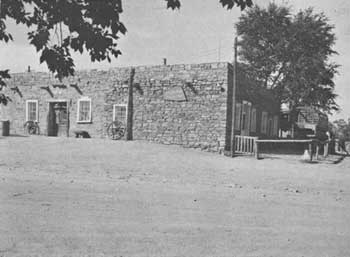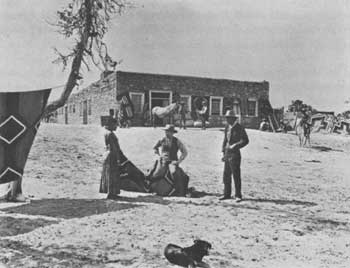





Survey of Historic Sites and Buildings
  |
HUBBELL TRADING POST NATIONAL HISTORIC SITE Arizona |
 |
| ||
This national historic site preserves the Hubbell Trading Post, still an active trading post after serving the Navajo Indians for more than 90 years, as a living example of a reservation trading post of yesterday. It typifies the role of such posts in Indian life and their contributions to the acculturative process.
The reservation trading post was the final manifestation of the Indian trade, a dominant factor in shaping the history of the North American Continent. From the earliest times, when the trade provided a motive for European colonization and influenced the course of subsequent colonial expansion, the trader achieved an importance among the Indian tribes unequaled by any other white man. After the American Revolution, large fur companies, operating out of isolated frontier outposts, gained the ascendancy over independent fur traders and triumphed over the Government's "factory" system. The companies dominated the trade for more than half a century until the advance of settlement and the beginning of the Indian wars destroyed their pattern of operations. Roving traders, often unscrupulous men bartering arms, ammunition, and liquor for Indian furs and goods, came to predominate. Gradually, between 1840 and 1890, as one tribe after another capitulated to the Army and were confined on reservations, the roving traders vanished.
 |
| Hubbell Trading Post National Historic Site. (National Park Service) |
Perhaps even more influential than his predecessors was the reservation trader, who was licensed by the Government and set up permanent posts on reservations amid newly conquered tribes. Not only did he supply the Indians with the white man's goods, but he helped them adapt their economy to reservation life, transmitted to them aspects of white civilization and material culture, and aided them in adjusting to their new way of life. In carrying out these activities, he also helped the U.S. Government fulfill its objectives in setting up reservations—to control and "civilize" the Indians.
The owner of Hubbell Trading Post for more than 50 years, John Lorenzo Hubbell, the "King of Northern Arizona," epitomized the reservation trader. The son of a Connecticut Yankee who had married into a New Mexico family of Spanish descent, Hubbell was born in Pajarito, N. Mex., in 1853. In the early 1870's he traveled throughout northern Arizona and southeastern Utah and became familiar with the customs and language of the Navajos. He worked for a time as a clerk in a Mormon trading post and in 1874 as an interpreter at the Navajo Agency at Fort Defiance, Ariz. In 1878, 2 years after he began trading in Arizona, he purchased William Leonard's trading post west of Ganado, the site of the present post. A shrewd businessman and beyond question the dean of the Navajo traders, Hubbell eventually built up a trading empire that included 14 trading posts, a wholesale house in Winslow, Ariz., and a stage and freight line. The hospitality of "Lorenzo the Magnificent," as Theodore Roosevelt dubbed him, was legendary throughout the Southwest and nearly everyone of importance who passed through northeastern Arizona visited him at his post. He was also active in county, State, and national politics.
But the most important aspect of Hubbell's personality and career was his friendship with the Navajo people. Coming to the reservation at a critical time in the history of the Navajos, when the suffering of the "Long Walk" and confinement at Fort Sumner, N. Mex., was still fresh in their minds, more than any other man he helped them adjust to reservation life. From the beginning they flocked to the post, where he was not only their merchant, but was also their teacher in understanding the ways of the white man and often their spokesman and contact with the outside world. He translated and wrote letters for them, arbitrated family quarrels, explained Government policy, and cared for the sick. Once he dined 300 Navajos in his hacienda. One of his most significant achievements was encouraging them to develop craftwork, especially silversmithing and blanket and rug weaving, into profitable industries that provided the basis for a sound economy. Although a devout Roman Catholic, Hubbell was instrumental in persuading the Presbyterian Church to establish in 1901 a mission and school in Ganado and even took the missionaries into his home for a year while the mission was being built.
 |
| John Lorenzo Hubbell trading for a Navajo blanket about 1905. (photo by Ben Wittick, Museum of New Mexico) |
Hubbell's death in 1930 was mourned by the Navajos probably more than that of any other white man they had known. He was buried on Hubbell Hill, overlooking the trading post, next to his wife and his closest Navajo Friend, Many Horses. Members of his family continued to operate the post. Shortly after World War II, trading posts on the Navajo Reservation began to decline as the customs of the inhabitants modernized.
In the National Park System since 1965, Hubbell Trading Post, surrounded by the Navajo Reservation, is still operated as an active trading post by the Southwestern Monuments Association under an agreement with the National Park Service. Barely changed since Hubbell completed the present post about 1900 to replace an earlier, smaller structure, it helps the visitor to visualize and understand the pattern of Navajo trade, the type of man who conducted it, and the kind of life he lived. The long, stone trading post, with its wareroom, storeroom, office, and rugroom, appears much as it did in Hubbell's time and resembles other Navajo trading posts. The original massive counters still dominate the storeroom; the office furniture is more than half a century old; and the rugroom contains antique firearms, Indian craftwork, paintings, and a variety of rugs. Hubbell's rambling adobe hacienda retains all its charm and portrays the manner in which reservation traders lived. The barn and utility buildings, most of stone construction, round out the picture of a trading post of yesteryear.
NHL Designation: 12/12/60
 |
 |
http://www.cr.nps.gov/history/online_books/soldier-brave/sitea4.htm
Last Updated: 19-Aug-2005